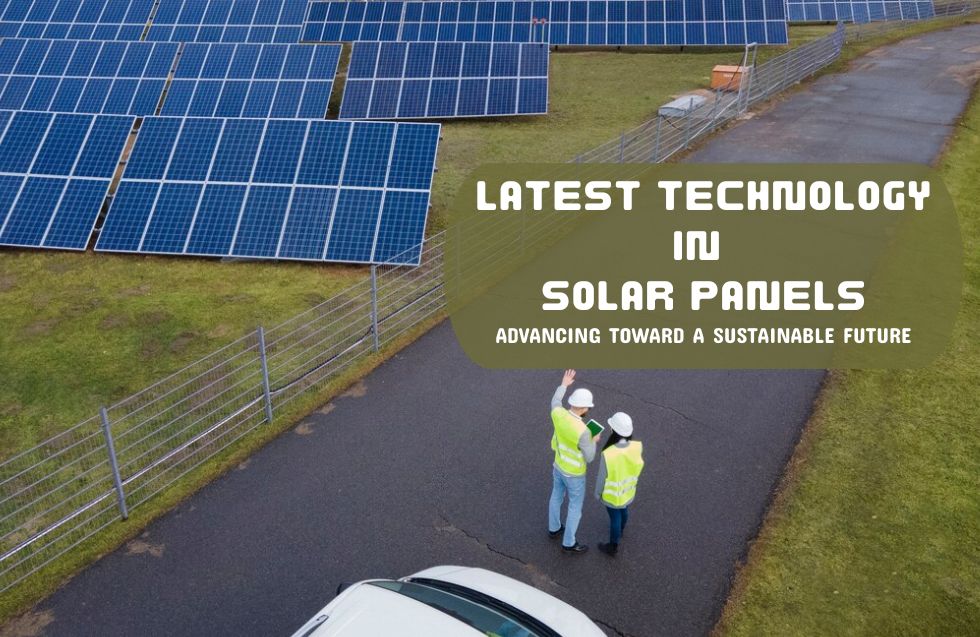Solar technology is evolving rapidly, driven by the need for cleaner energy solutions and the global shift toward sustainability. Recent advancements in solar panels have made them more efficient, affordable, and versatile than ever before. Here’s an overview of the latest technologies transforming the solar energy landscape:
1. Bifacial Solar Panels
Bifacial solar panels are designed to capture sunlight on both sides of the panel, increasing energy production by up to 30% compared to traditional monofacial panels. By utilizing both the direct sunlight on the front and the reflected sunlight on the back, bifacial panels are especially effective in areas with high albedo surfaces like snow or sand. Their innovative design allows for more electricity generation in the same footprint, making them ideal for residential and commercial installations.
Applications:
- Residential and Commercial Rooftops: Bifacial panels can be installed on roofs with reflective surfaces, increasing electricity generation.
- Ground-Mounted Solar Farms: In open areas with reflective ground surfaces (like sand or snow), bifacial panels maximize energy output.
- Solar Canopies and Carports: These panels can be used in parking areas, allowing sunlight to hit both the top and bottom of the panels.
Benefits:
- Increased Efficiency: Capture sunlight from both sides, boosting energy production by up to 30%.
- Lower Cost of Energy (LCOE): The dual-sided nature means more electricity can be generated from the same area, lowering overall costs per watt.
2. Perovskite Solar Cells
Perovskite solar cells are one of the most exciting developments in solar technology. These cells use a special material that can convert sunlight into electricity at a much higher efficiency than traditional silicon-based solar cells. While silicon cells have plateaued in their efficiency gains, perovskite cells are still improving rapidly. The potential for perovskite to be used with existing silicon cells could lead to solar panels with efficiency rates exceeding 30%, breaking current limits. Additionally, perovskite cells can be manufactured using less expensive processes, which could dramatically reduce the cost of solar energy.
Applications:
- Solar Farms and Residential Rooftops: Due to their high efficiency and flexibility, perovskite cells are used in various types of installations.
- Building-Integrated Photovoltaics (BIPV): Perovskite cells can be used in window-integrated solar panels and facades.
- Portable Devices: Lightweight and flexible, they are ideal for portable electronics like solar-powered chargers or wearables.
Benefits:
- Higher Efficiency: Capable of converting more sunlight into electricity than traditional silicon cells.
- Lower Manufacturing Costs: The materials and processes involved in making perovskite cells are less expensive, potentially lowering solar costs.
3. Solar Skin Panels
Solar skin technology allows panels to blend seamlessly with the aesthetics of a building. The skin can be customized with images, patterns, or textures to match the roof’s appearance, making solar panels more visually appealing. This innovation can drive higher adoption rates, especially in residential markets where homeowners might hesitate to install conventional solar panels due to aesthetic concerns. The solar skin panels retain high efficiency while providing flexibility in design.
Applications:
- Residential Homes: Homeowners can match the solar panels with the design of their roof, maintaining aesthetics without sacrificing functionality.
- Corporate Buildings: Companies can integrate brand logos or designs into their solar systems for a unique marketing opportunity.
- Historical Buildings: Can be used to preserve the architectural integrity of heritage sites while still generating solar power.
Benefits:
- Aesthetic Appeal: Solar skin technology enables solar panels to blend with existing designs, reducing the visual impact of traditional solar panels.
- Higher Adoption Rates: The aesthetic customization can attract homeowners and businesses who prioritize design, increasing the adoption of solar energy.
4. Floating Solar Farms (Floatovoltaics)
Floating solar farms, or “photovoltaics,” are solar installations placed on bodies of water, such as lakes, reservoirs, or oceans. This technology has gained popularity as it solves land scarcity issues while offering higher efficiency due to the cooling effect of water on solar panels. Floating solar farms also help reduce water evaporation and algae growth, making them an attractive option for energy production in regions with large water surfaces.
Applications:
- Reservoirs and Lakes: Floatovoltaics are installed on bodies of water, turning unused surfaces into energy-generating areas.
- Agricultural Irrigation Ponds: Farmers can install floating panels to generate electricity while reducing water evaporation.
- Hydroelectric Dams: Floating solar farms can complement hydroelectric power generation.
Benefits:
- Land Conservation: Floating solar farms free up land for agriculture or other uses, making them ideal in densely populated regions.
- Cooling Effect: Water bodies keep the solar panels cooler, increasing their efficiency and extending their lifespan.
- Reduced Water Evaporation: Installing solar panels on water bodies reduces evaporation, preserving water resources.
5. Building-Integrated Photovoltaics (BIPV)
Building-integrated photovoltaics (BIPV) involves integrating solar panels directly into building materials, such as windows, roofs, or facades. This technology allows buildings to generate electricity without needing separate, bulky solar panels. Solar roof tiles, like those offered by Tesla, are one of the most well-known examples of BIPV. BIPV is becoming popular in new constructions as it merges design with functionality, offering clean energy while maintaining architectural aesthetics.
Applications:
- Skyscrapers and Office Buildings: Solar windows and facade-integrated panels provide clean energy for large commercial buildings.
- Residential Homes: Solar roof tiles replace traditional roofing materials, generating electricity while blending with the structure.
- Government and Municipal Buildings: BIPV can help cities reduce their carbon footprint and integrate sustainability into urban planning.
Benefits:
- Aesthetic Integration: Solar technology is seamlessly integrated into the building design, reducing the need for additional panels.
- Space Efficiency: BIPV uses existing structures like windows and facades, making solar power more accessible in urban environments with limited space.
- Energy Savings: These systems provide on-site energy generation, reducing reliance on the grid and lowering energy costs.
6. Quantum Dot Solar Cells
Quantum dot solar cells use nanoscale semiconductor particles that can absorb a wider range of the solar spectrum compared to traditional materials. This enables them to achieve high efficiencies even in low-light conditions. Quantum dots also have the potential to be more flexible, lightweight, and transparent, opening the door for their use in unconventional applications like solar-powered windows or wearable solar devices.
Applications:
- Low-Light Environments: Quantum dot solar cells are useful for cloudy regions or indoor applications, like solar windows in offices or homes.
- Portable Electronics: Their flexibility allows integration into smaller, portable devices such as smartphones and wearables.
- Smart Windows and Skylights: Quantum dot solar cells can be transparent and can convert sunlight through windows into energy.
Benefits:
- Efficient Low-Light Performance: Can generate electricity even in diffuse light conditions, making them suitable for regions with less sunlight.
- Lightweight and Flexible: Their flexibility opens up applications in unconventional areas like smart devices, clothing, and solar-powered windows.
- Potential for Transparency: This technology can create transparent solar panels, expanding solar applications without aesthetic trade-offs.
7. Concentrated Solar Power (CSP)
Concentrated Solar Power (CSP) is a technology that uses mirrors or lenses to concentrate sunlight onto a small area, which then generates heat to drive a turbine and produce electricity. Unlike photovoltaic solar panels that convert sunlight directly into electricity, CSP systems focus on heat generation. New innovations in CSP include hybrid systems that combine solar power with thermal storage, enabling continuous power generation even when the sun isn’t shining. CSP is particularly effective for large-scale power plants and utility-grade solar farms.
Applications:
- Utility-Scale Power Plants: CSP is ideal for large solar farms generating electricity for the grid.
- Industrial Applications: CSP systems are used to generate high-temperature heat for industries such as cement, steel, and chemical production.
- Hybrid Energy Systems: CSP can be combined with traditional power plants to provide additional energy during peak demand.
Benefits:
- 24/7 Power Generation: With thermal storage, CSP plants can generate electricity even when the sun isn’t shining, offering reliable, continuous power.
- Reduced Carbon Emissions: CSP can significantly reduce the need for fossil fuels in industrial processes.
- Scalability: CSP plants can be built on a large scale, providing vast amounts of electricity.
8. Solar Energy Storage Advancements
Solar energy storage is becoming increasingly critical as solar power grows. Technologies like lithium-ion batteries, solid-state batteries, and flow batteries are being improved to store more energy at lower costs. Innovations in battery management systems, combined with better storage capacities, allow homeowners and businesses to store excess solar energy for use during the night or on cloudy days, making solar energy a more reliable source of power.
Applications:
- Residential Homes: Homeowners with solar panels can store excess electricity in advanced batteries for use during the night or power outages.
- Commercial Buildings: Large-scale battery storage helps businesses avoid high energy costs by using stored solar energy during peak hours.
- Off-Grid Systems: In rural or remote locations, solar storage batteries are critical for ensuring continuous power supply.
Benefits:
- Energy Independence: Solar storage allows for greater energy self-sufficiency, reducing reliance on the grid.
- Cost Savings: Storing energy during low-demand times and using it during peak demand can lower electricity bills.
- Reliability: Energy storage ensures that solar energy can be used even when sunlight isn’t available, making solar more dependable.
9. Smart Solar Panels and IoT Integration
With the rise of smart home technology, solar panels are now being integrated into the Internet of Things (IoT). Smart solar panels come equipped with sensors and monitoring systems that allow users to track performance, energy production, and panel health in real-time. These panels can also communicate with other smart devices in a home, optimizing energy consumption based on electricity demand, weather conditions, and energy prices.
Applications:
- Smart Homes: Solar panels integrated with IoT allow for remote monitoring and optimization of energy usage within smart homes.
- Commercial Buildings: Businesses can monitor solar energy production in real time, improving efficiency and reducing operational costs.
- Energy Grids: Smart solar panels can communicate with the grid, optimizing energy flow based on supply and demand.
Benefits:
- Real-Time Monitoring: Users can track their system’s performance, energy output, and efficiency through apps or IoT platforms.
- Energy Optimization: Smart solar systems can balance energy use across devices, reducing waste and improving efficiency.
- Predictive Maintenance: IoT integration allows for proactive system maintenance, ensuring panels are always running at peak performance.
10. Transparent Solar Panels
Transparent solar panels are an emerging technology that could revolutionize the way solar energy is integrated into everyday life. These panels are made of transparent photovoltaic materials, allowing them to be used in windows, smartphone screens, or even car sunroofs without compromising visibility. While still in the early stages of development, transparent solar panels hold enormous potential for expanding solar power applications to new and unconventional areas.
Applications:
- Skylights and Windows: Transparent solar panels can replace conventional glass windows in homes, offices, and cars to generate power.
- Smartphones and Tablets: Transparent panels could power electronic devices like phones or tablets, providing renewable energy on the go.
- Public Transport: Transparent panels can be used in the windows of buses, trains, and cars to supplement power needs.
Benefits:
- Dual Functionality: Provides energy without sacrificing natural light, making it perfect for buildings with large glass surfaces.
- Broader Applications: These panels can be used in spaces where traditional opaque panels wouldn’t work, like windows or car sunroofs.
- Aesthetic Appeal: Transparency allows for sleek, modern designs in architecture and transportation.
Conclusion
The latest advancements in solar panel technology are opening new possibilities for both residential and commercial use. From bifacial panels to perovskite cells and floating solar farms, the future of solar energy is both bright and innovative. As technology continues to evolve, solar power will become an even more efficient and accessible energy source, driving the world closer to a sustainable, renewable future.
By embracing these new solar technologies, businesses and homeowners can not only reduce their carbon footprint but also contribute to a cleaner, greener planet. The transition to solar energy is no longer a question of if, but when, as the industry continues to deliver cutting-edge solutions.












